— These women’s mystical writings invite us to look beyond cultural assumptions and deepen our relationship with Christ.
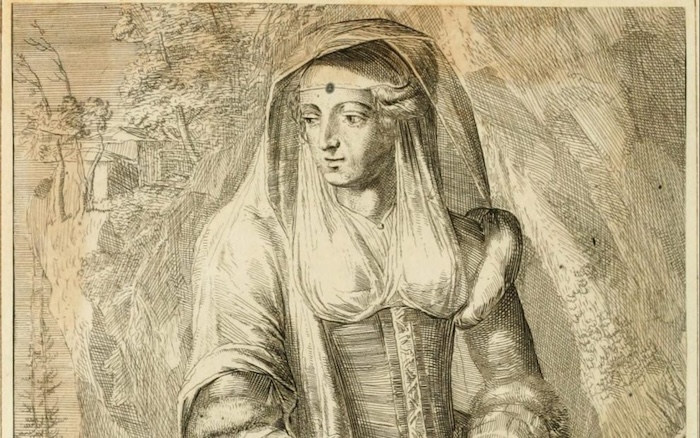
By Ellyn Sanna
“Who do you say I am?” asks Jesus in Luke’s gospel (9:20). His words imply he’s not interested in doctrine or theology. He wants a personal response, not a repetition of the party line.
Female mystics during the Middle Ages were one group who felt free to come up with their own replies. In Jesus, medieval women found someone who was “neither male nor female” (Gal. 3:28).
And yet, isn’t maleness an aspect of Jesus’ identity that’s self-evident? How can there be any room for ambiguity? Somehow, though, the personhood of Jesus drew a new perspective even in the context of medieval patriarchy. Today, queer theology affirms that those medieval women were absolutely right: There’s a larger, more inclusive answer to the question of Jesus’ gender.
Before we react for or against that statement, let’s be sure we understand how queer theology defines itself. To be “queer,” according to definitions queer scholars use, doesn’t necessarily mean to be homosexual. Tyson Pugh, author of Queering Medieval Genres (Palgrave Macmillan), points out that queerness is not a term related to either hetero- or homosexual relationships but rather a concept that totally disrupts our ideas about sexuality. Queer theology, Pugh says, makes room for people and ideas that may not fit into the binary categories of “straight” and “gay.”
Women mystics during the Middle Ages would have had no problem with this. And they were quite comfortable with a gender-bending Jesus. These women answered Jesus’ question— “Who do you say I am?”—in ways that may seem to verge on blasphemy.
When we look back at the Middle Ages, though, historians remind us we shouldn’t use our 21st-century lens. Sexuality was not defined then the same as it is today. Amy Hollywood, in her book Queer Theology (Blackwell), writes that in the Middle Ages, “men and women tended to be perceived as the ends of the same continuum rather than as diametrically opposed to each other as they are today.” The words homosexuality and heterosexuality didn’t even exist until the late 19th century, and these binary concepts would not have matched up with medieval perspectives.
This is why no one had a problem with women mystics describing their experiences in the language of a modern-day bodice-ripper; piercing, penetrating, ravaging, burning, and ecstasy are all words lifted straight from their writings. St. Teresa of Ávila, the great 16th-century doctor of the church, writes that her mystic encounters with Jesus leave her “all on fire,” moaning from the “exceeding sweetness.”
In the 12th century, Hildegard of Bingen equates Jesus with caritas (love, a feminine being). Sometimes Jesus is Hildegard’s male lover wooing her, but more often Hildegard takes the masculine role of a knight pursuing Jesus, her female lover. In the writings of medieval women such as Hildegard, says Hollywood, “gender becomes so radically fluid that it is not clear what kind of sexuality—within the heterosexual/homosexual dichotomy readily available to modern readers—is being . . . employed to evoke the relationship between humans and the divine.”
Hadewijch, a 13th-century mystic, also names Jesus with the feminine word for love. “He who wishes to serve love,” she writes, referring to her own soul in relationship with Jesus, “must surrender himself into her power.” Then, later in the same poem, she refers to herself as a woman wooed by love, slain by “her touch.” In another poem, Hadewijch writes, “You who can conquer all with wonder! Conquer me, so I may conquer you.”
In a similar way, Mechthild of Magdeburg, also in the 13th century, writes these confusing lines, referring to her relationship with Jesus: “He surrenders himself to her, and she surrenders himself to her.” The boundaries between male and female have become permeable, allowing all the variations of human sexuality to meld into a fluid unity.
In her book Power, Gender, and Christian Mysticism (Cambridge University Press), historian Grace Jantzen writes that women mystics describe “direct, highly charged, passionate encounters between Christ and the writer. The sexuality is explicit.” These medieval women claimed the eroticism of their own bodies as a form of spiritual power.
Not all medieval mystics thought of Jesus as a lover—but they still engaged in confusing gender bending, where roles shifted, blended, and merged. Margery of Kempe in 14th-century England identifies with Jesus as being like her in his womanhood, but she also says she gives birth to him as his mother. Her contemporary, the woman mystic Julian of Norwich, describes Jesus’ blood on the cross as resembling menstrual blood; Jesus is a woman like herself. She also insists he is the embodiment of all true motherhood, and she refers to him throughout her writing as “our Mother.”
During the Middle Ages, far more women than men were mystics. This may have been because women identified with the physicality of Jesus’ life, for they too suffered and bled, birthed and nourished, and often died in the process. Their bodies, the very part of them men said was corrupt, gave them entryway into spiritual intimacy with Christ. Intense mystical experiences also freed women from the rules and roles the patriarchy imposed. Their mysticism did not lift them into some higher noncorporeal plane but, instead, grounded the spiritual world in their own experiences as women. Mysticism gave women’s voices back to them. On the grounds of this spiritual authority, women could even write books.
Claiming this authority was tricky, though. According to Jean Gerson, a prominent 14th-century philosopher and scholar, “The female sex is forbidden on apostolic authority to teach in public, that is either by word of mouth or writing. . . . All women’s teaching is to be held suspect . . . because they are easily seduced and determined seducers.” But if women mystics spoke with Jesus’ voice, then men could accept their messages as coming straight from God. In that case, women would be like empty straws through which the divine could flow.
“I am a poor little woman,” writes Mechthild, “but I write this book out of God’s heart and mouth.” Hildegard—a polymath author, artist, musician, botanist, astronomer, and physician—refers to herself as “a weak and fragile rib.” Julian of Norwich, whose theology is as brilliant and relevant today as it was in the 14th century, claims she is “ignorant, weak, and frail.” Only by apologizing for themselves, by casting themselves as invisible and unworthy carriers of Christ’s message, could these women be taken seriously (and hopefully avoid the mortal danger of being condemned as heretics).
And yet, despite the need for subterfuge and apology, medieval women proclaimed the holiness of their own bodies. When they looked at Jesus, they saw someone outside the patriarchy, someone who understood them and affirmed them spiritually but also physically. Through Jesus, they claimed their sexuality in a space where no human male could enter. “You are me,” these women said to Jesus, “and I am you. We are one.”
Christ has been defined in many ways over the centuries and around the world—but the real question has always been: What is your relationship with Jesus? If we expand our answers to this question, looking beyond our cultural assumptions, we too, like medieval women, may find entryway into a deeper relationship with Christ.
Then, far more than those medieval women, we have the power to pull our understanding of the incarnation out beyond our own souls, into our society. Our answers to Jesus’ question can stretch beyond gender, beyond race, beyond creed. Relationship with a queer Jesus might even smash the barriers of hate and fear we’ve built between us.
So—who do you say Jesus is?
Complete Article ↪HERE↩!
Step by step, Francis has made the Catholic Church a more welcoming place for LGBTQ people
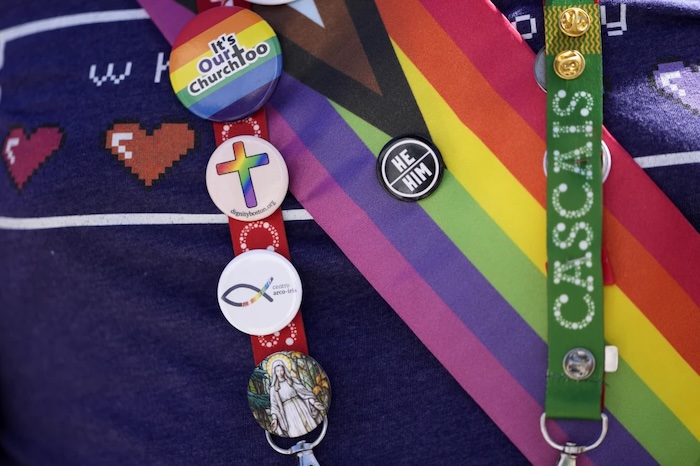
By DAVID CRARY
The Catholic Church, in its doctrine, still rejects same-sex marriage and condemns any sexual relations between gay or lesbian partners as “intrinsically disordered.” Yet Pope Francis, during his nearly 11-year papacy, has done far more than any previous pope to make the church a more welcoming place for LGBTQ+ people.
It became clear early in Francis’ papacy that he was going to articulate a gentler, more tolerant approach. The initial high-profile moment came in 2013 — during the first broadcast news conference of his papacy — with his memorable “Who am I to judge” comment when he was asked about a purportedly gay priest.
Signals of this approach had come earlier. As archbishop of Buenos Aires, he had favored granting legal protections to same-sex couples as an alternative to endorsing gay marriage, which Catholic doctrine forbids. The Vatican confirmed in 2020 that this was indeed the pope’s belief.
Some recent highlights:
In January 2023, Francis assailed the laws on the books in many countries that criminalize homosexuality and called for their elimination
“Being homosexual isn’t a crime,” Francis said during an interview with The Associated Press.
In 2008, under Pope Benedict XVI, the Vatican had declined to sign onto a U.N. declaration calling for an end to such laws.
Francis acknowledged that Catholic bishops in some regions support laws that criminalize homosexuality or discriminate against LGBTQ people. But he attributed such attitudes to cultural backgrounds, and said bishops need to recognize the dignity of everyone.
___
Another reversal came in late 2023, when the the Vatican made public a statement saying it’s permissible, under certain circumstances, for transgender people to be baptized as Catholics and serve as godparents.
The document was signed by Francis and Cardinal Víctor Manuel Fernández, who heads the Vatican’s Dicastery for the Doctrine of the Faith.
If it did not cause scandal or “disorientation” among other Catholics, a transgender person “may receive baptism under the same conditions as other faithful,” the document said.
Similarly, the document said trans adults — even if they had undergone gender-transition surgery — could serve as godfathers or godmothers under certain conditions.
The new pronouncement reversed the absolute bans on transgender people serving as godparents issued by the Vatican doctrine office in 2015. Among the beneficiaries: a community of transgender women — many of them Latin American migrants who worked in Rome as prostitutes — who made monthly visits to Francis’ weekly general audiences and were given VIP seats.
The pope’s outreach to trans people contrasts with the stance of some conservative Catholic prelates. In the United States, several dioceses have targeted trans Catholics with restrictions and refusals to recognize their gender identity. Yet at the same time, a growing number of U.S. parishes have welcomed trans people.
___
The pope’s mixed record on LGBTQ+ issues was epitomized by the Vatican’s 2023 synod bringing together hundreds of bishops and lay people from around the world to confer on the future of the church. The advance agenda specified that LGBTQ+ issues would be discussed; one of Francis’ hand-picked delegates was the Rev. James Martin, a U.S.-based Jesuit priest who is one of the most prominent advocates of greater LGBTQ+ inclusion in the church.
Yet when the final summary of the three-week synod was released, there was not a single mention of LGBTQ+ people, reflecting the influence of Catholic conservatives who oppose Francis’ overtures to that community.
___
On Monday, the Vatican released a document in which Francis formally approved allowing priests to bless same-sex couples, stipulating that people seeking God’s love and mercy shouldn’t be subject to “an exhaustive moral analysis” to receive it.
The document elaborates on a letter Francis sent to two conservative cardinals that was published in October. In that preliminary response, Francis suggested such blessings could be offered under some circumstances if they didn’t confuse the ritual with the sacrament of marriage.
The new document repeats that condition and elaborates on it, reaffirming that marriage is a lifelong sacrament between a man and a woman. And it stresses that blessings in question must be non-liturgical in nature and should not be conferred at the same time as a civil union, using set rituals or even with the clothing and gestures that belong in a wedding.
Even with these conditions, it’s a marked change from 2021, when the Vatican’s Congregation for the Doctrine of the Faith said flat-out that the church couldn’t bless the unions of two men or two women because “God cannot bless sin.”
Complete Article ↪HERE↩!
‘Excuse me, Your Eminence, she has not finished speaking’
— Francis’ opening to women in church management is promising. Getting women into the sacristy is trickier.
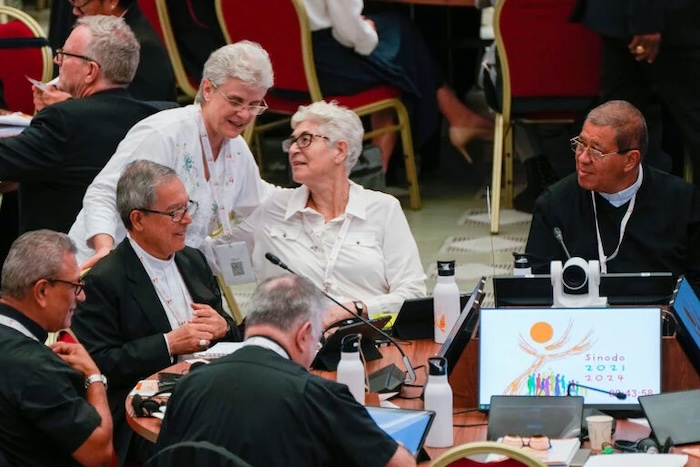
Without doubt, the best line to emanate from the Synod on Synoldality is “Excuse me, Your Eminence, she has not finished speaking.”
That sums up the synod and the state of the Catholic Church’s attitude toward change.
In October, hundreds of bishops, joined by lay men and women, priests, deacons, religious sisters and brothers met for nearly a month in Rome for the Synod on Synodality. At its end, the synod released a synthesis report brimming with the hope and the promise that the church would be a more listening church.
Some 54 women voted at the synod. Back home, women are still ignored.
Why?
It is not because women quote the Second Vatican Council at parish council meetings. It is because too many bishops and pastors ignore parish councils.
It is not because women of the world do not write to their pastors and bishops. It is because without large checks, their letters are ignored.
The Synod on Synodality was groundbreaking in part because it was more about learning to listen. It was more about the process than about results. Its aim was to get the whole church on board with a new way of relating, of having “conversations in the Spirit,” where listening and prayer feed discernment and decision-making.
Even now, the project faces roadblocks. At their November meeting this week in Baltimore, U.S. bishops heard presentations by Brownsville, Texas, Bishop Daniel Flores, who has led the two-year national synod process so far. His brother bishops did not look interested.
To be fair, some bishops in some dioceses, in the U.S. and other parts of the world, are on board with Pope Francis’ attempt to encourage the church to accept the reforms of Vatican II, to listen to the people of God.
But too many bishops are having none of it.
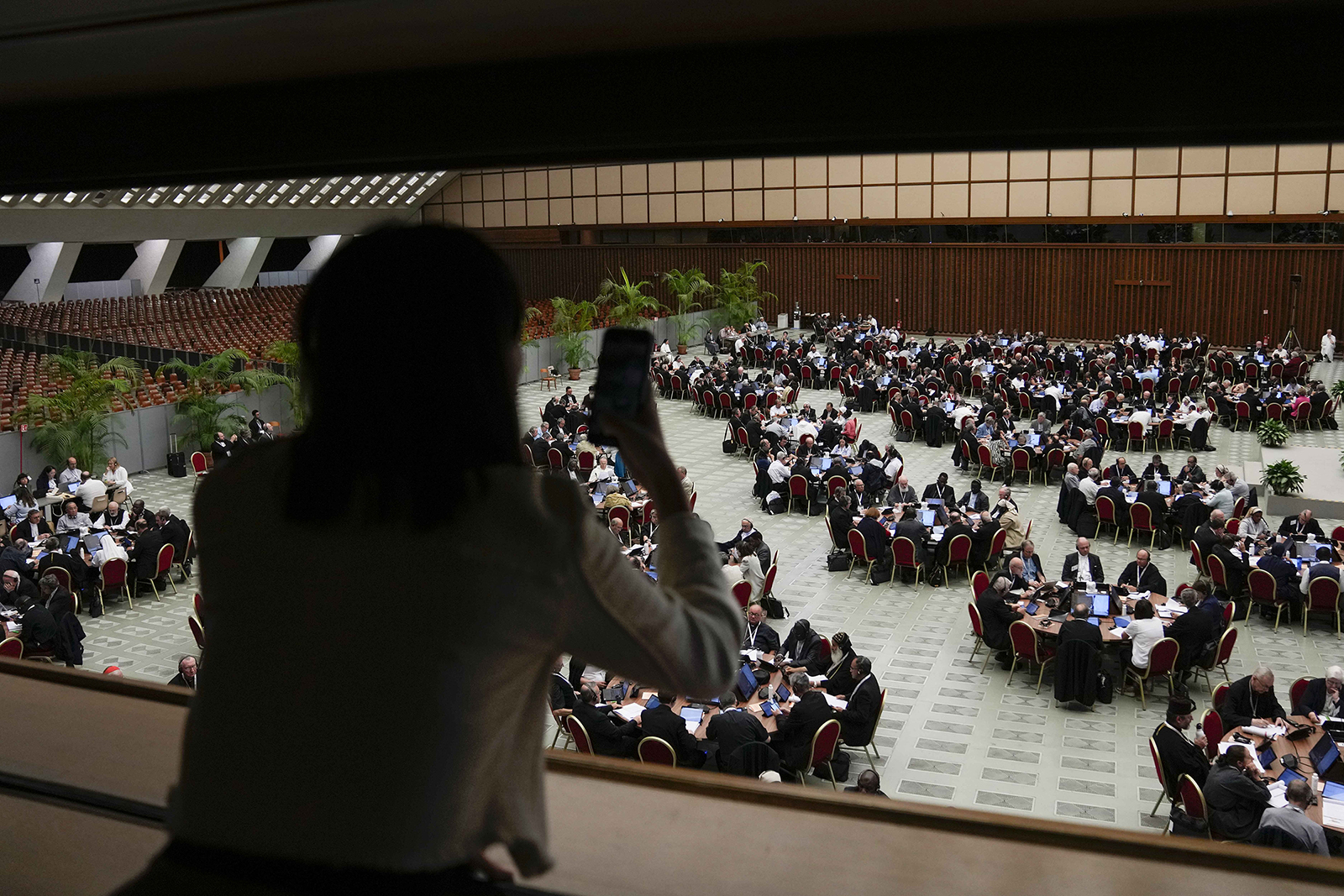
The synod recognized the church’s global infection with narcissistic clericalism. It said fine things about women in leadership and the care of other marginalized people. Yet the synod remains a secret in many places. Its good words don’t reach the people in the pews.
Ask about synodality in any parish, and you might hear “Oh, we don’t do that here.” You are equally likely to hear “When I” sermons (“When I was in seminary,” “When I was in another parish”), and not about the Gospel.
Folks who were excited by Francis’ openness and pastoral message just shake their heads.
The women who want to contribute, who want to belong, are more than dispirited. They have had it. And they are no longer walking toward the door — they are running, bringing their husbands, children and checkbooks with them.
In the Diocese of Brooklyn, it was recently discovered that Mass attendance had dropped 40% since 2017. It is the same in too many places. The reason the church is wobbling is not a lack of piety. It is because women are ignored. Their complaints only reach as far as the storied circular file.
What do women complain about? Bad sermons, as discussed. Autocratic pastors. And the big one: pederasty. If truth be told, women do not trust unmarried men with their children. Worldwide, in diocese after diocese, new revelations continue. Still.
Many bishops and pastors understand this. Francis certainly does, but he is constrained by clerics who dig their heels into a past many of them never knew. More and more young (and older) priests pine for the 1950s, when priests wore lace and women knew their place. That imagining does not include synodality.
Will the synod effort work? Francis’ opening to women in church management is promising. Where women are in the chancery, there is more opportunity for women’s voices to be heard. No doubt, a few more women there could help.
Getting women into the sacristy is trickier.
While it seems most synod members agreed about restoring women to the ordained diaconate as a recognition of the baptismal equality of all, some stalwarts argued it was against Tradition. Still others saw the specter of a “Western gender ideology” seeking to confuse the roles of men and women.
So, they asked for a review of the research. Again.
Women know the obvious: Women were ordained as deacons. There will never be complete agreement on the facts of history, anthropology and theology. Women have said this over and over.
If there is absolute evidence that women cannot be restored to the ordained diaconate, it should be presented, and a decision made.
The women have finished speaking about it.
Complete Article ↪HERE↩!
The meaning behind Pope Francis’ meeting with transgender people

By: Newsy
Father James Martin has taken his message of prayer and inclusivity everywhere, from “The Late Show with Stephen Colbert” to the halls of the Vatican. In May, he wrote to Pope Francis with a few questions.
“I just wanted to give him a time to briefly talk to LGBTQ Catholics,” Martin said.
Francis has extended apologies to the abused and a welcome to the historically rejected. According to the Vatican News, he recently met with transgender people near Rome, Italy.
So Martin’s questions aren’t so random.
“I asked him, ‘What would you most like them to know about the church?'” Martin said. “He said, ‘Read Acts of the Apostles,’ which was really interesting because there’s a church that’s kind of mixing it up. Then also, ‘What would you say to an LGBTQ Catholic who felt rejected by the church?’ And he said very interestingly to remember that it’s not the church that rejects you, the church loves you, but it might be individual people in the church.”
It isn’t the first time Francis has corresponded directly with Martin on LGBTQ relations or the first time he has spoken up about their place within the Catholic church.
In 2016, Francis agreed the church should apologize to not only gay people but other marginalized groups, like the poor. He’s also called for parents to accept their LGBTQ children.
Francis’ gestures are one thing; changing church doctrine, which teaches that the act of homosexuality is sinful, is another.
“What would have happened really, in a sense, is for theologians working together, along with church officials, to come to some newer understanding of how they can accommodate for older church teaching on these issues, to show that the church evolves rather than dramatically changing,” said Michele Dillon, professor of sociology at the University of New Hampshire. “Because the church is not going to say, ‘Oh, we were wrong.’ It’s very rare.”
“If he were to do that, which I don’t think Pope Francis will, but if he were to do that, he would not want to do it without support from the Curia and the College of Cardinals,” said Cristina Traina, professor of Catholic theology at Fordham University. “He would not want to do it without tracing a pathway theologically.”
Instead, Francis has gone another direction: one met with both criticism and praise, uplifting LGBTQ Catholics while simultaneously reiterating church doctrine.
NEWSY’S AMBER STRONG: Is he sort of riding the line between saying that this is doctrine and doctrines not going to change? But, we also still need to love and affirm people as well.
FATHER JAMES MARTIN: I think that’s a good question, and I think he is kind of trying to straddle that line. But I think one thing to remember is that what seems very bland and tepid in the United States — overseas is a big deal. In the U.S., we might say, ‘Oh, big deal. Of course, you should welcome your kids.’ If you’re in Eastern Europe or sub-Saharan Africa or Latin America or India, that’s a big deal. So, we have to remember that he’s speaking to the whole church.”
According to Pew Research, 76% of U.S. Catholics say society should be accepting of homosexuality. That’s below the rate of Catholic support in countries like Spain and the Netherlands but far higher than places like Lebanon and Nigeria.
Some theologians argue that Francis’ support could have a trickle-down impact on individual Catholics and parishes.
“These things can do a lot to encourage Catholics to embrace LGBTQ people with love and compassion and mercy and not to see them as the Antichrist, the anathema, the enemy of salvation,” Traina said.
In 2021, a group of Catholic leaders, including a cardinal and archbishop, signed a statement calling for widespread support of at-risk LGBTQ youth. According to an NCR analysis of recent listening sessions among U.S. Catholics, there was a growing call for LGBTQ inclusion and more opportunities for women.
“To me, there’s no such thing as an empty gesture because, yes, many times people want to see more clear-cut evidence of change and of their acceptance within the church, but sometimes it’s in small steps,” Dillon said.
In 2021, Martin, a Vatican appointee under Francis, launched Outreach: a website that provides resources to LGBTQ Catholics and leaders. It’s an effort Pope Francis has encouraged.
“He hasn’t changed any church teaching,” Martin said. “I’m not advocating for any church teaching, but he’s advocated a more pastoral response, listening to them, welcoming them, treating them with respect.
Complete Article ↪HERE↩!
My Catholic, trans child is living proof of how wrong the Vatican is on gender
No, my child’s transition has not led to the ‘destabilisation of the family institution’. Instead, we are stronger than ever
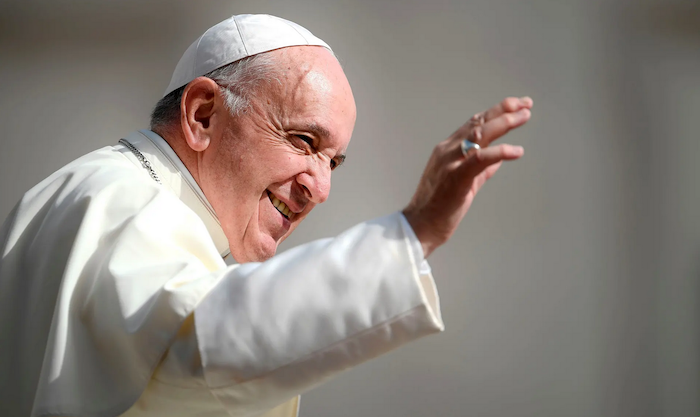
By
The recent document from the Vatican’s Congregation for Catholic Education talks of an “educational crisis”, and alleges that discussions in relation to gender have “helped to destabilise the family as an institution”. As the parent of a trans child, I find this hugely disappointing.
I have two teenage daughters. Their dad is Catholic, and they’ve been raised in the Catholic faith. When our youngest came out as transgender, we struggled. This was five years ago, and there was limited coverage of trans people in the media. We struggled in our own minds – how can our child know so young? What if she’s wrong? What does this mean? We struggled with our families – unsure of how to tell them, or indeed how they would react. We struggled with our church – would we still be welcome? Should we find a different one? A different school?
I met with the senior leadership team of our Catholic primary school to discuss support. I also sat with our parish sister, and talked over many cups of coffee. Her response has stayed with me. “We are talking about a child. There will be people who don’t understand. The world is changing, and the church can be slow to catch up. But your child should be treated with love, compassion and kindness. Who are we to turn our backs on her?”
Staff at the primary school explained to fellow pupils, in an age-appropriate way, why our child would be using a different name and pronouns after the school holiday. The only change at this stage is a social one – there is no medical intervention. I contacted some of the parents. Messages of support came flooding back.
The year after her social transition, we flew to Ireland for a wedding. This would be the first time that many aunts, uncles and cousins (as well as my 86-year-old mother-in-law) had met our daughter as her true authentic self. Again, as parents we were nervous. These are the people we care about most in the world; how would they respond to our child? The love from family was overwhelming. There will always be those who do not understand, but I saw the relief my daughter felt at being accepted and not ridiculed. Every day I see her thrive and grow in confidence. I am proud of her.
My child’s transition has not led to the “destabilisation of the family institution”. If anything, family bonds are stronger. Her relationship with her grandparents is a joy to behold. She and her sister argue (most siblings do), but there is a closeness that was missing previously. I’ve thought long and hard about why that is. Honestly? She is no longer pretending to be someone she is not. She can relax and be herself.
The Vatican says you can’t choose your gender. Trans and non-binary people don’t “choose” their gender. They know who they are, and they wish to live authentically and happily. What I will say is that families, friends, communities and congregations can choose how to respond. In our case, they have responded with love, compassion and respect, even when they don’t understand.
As I said at the start, I have two teenage daughters. Both now attend our local Catholic secondary school. Both are thriving and happy. Pope Francis envisions an inclusive church – our experience as a family is a reminder that God welcomes all, even and especially those whom society rejects. Our community is made up of people living their faith with compassion through their actions. That, to me, is true Christianity.
Complete Article ↪HERE↩!
